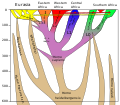| DescriptionHomo sapiens lineage.svg |
English: Simplified phylogeny of the species Homo sapiens (modern humans) for the last 600,000 years.
Based on Schlebusch et al., "Southern African ancient genomes estimate modern human divergence to 350,000 to 260,000 years ago"
Science, 28 Sep 2017, DOI: 10.1126/science.aao6266 (preprint),
Fig. 3: "Demographic model of African history and estimated divergences"[1]:
Horizontal lines represent migration, with upward-pointing triangles representing admixture into another group.
The six major divisions of modern humans are given as: Non-Africans (yellow), East Africans (orange), West Africans (red), Central African hunter-gatherers [African Pygmies] (blue), northern Khoi-San [NKSP] (green) and southern Khoi-San [SKSP] (green), mapped according to their broad historical distribution. Estimated split times given in the source cited (in kya): Human-Neanderthal: 530-690, Deep Human [H. sapiens]: 250-360, NKSP-SKSP: 150-190, Out of Africa (OOA): 70-120.
For a caveat of these divergence times possibly being too early: see "Khoisan May Not Have Diverged ~300,000 Years Ago":
- "a prominent geneticist who is very conversant with these issues is simply incredulous about the likelihood of this particular value. I brought up this preprint to them over lunch and they just didn’t buy it. That is, they are skeptical that the amount of admixture would have skewed the earlier inferences to the magnitude that they seem to have in these results. The authors in the paper used G-PhoCS and their own ingenious method to come to these inferences of split dates. The problem with these methods is that the inferences generated aren’t nearly as straightforward as an admixture estimate (which can be checked by something as simple as a PCA)."
- Representation of archaic (non-Homo-sapiens) admixture is based on: Stringer, C. (2012). "What makes a modern human". Nature 485 (7396): 33–35. doi:10.1038/485033a, with modifications:
- H. heidelbergensis is shown as the link between Neanderthals, Denosiovans and H. sapiens
- Admixture of Denisovans and Neanderthals to non-African Homo sapiens after OOA
Note: evidence published since 2016 makes it less likely that H. heidelbergensis is the Neanderthal-sapiens-MRCA.
Neanderthal-sapiens divergence is now more likely further back, between about 700 and 800 kya, H. heidelbergensis is entirely within the Neanderthal lineage, and the mrca is more likely (identical with or close to) H. antecessor.
If these recent results are to be represented in the diagram, its scope will need to be extended to 800 kya. Literature:
- Alan R. Rogers, Ryan J. Bohlender, Chad D. Huff, "Early history of Neanderthals and Denisovans", PNAS 114 (37), 12 September 2017, 9859-9863, doi.org/10.1073/pnas.1706426114 (Jordana Cepelewicz, Genetics Spills Secrets From Neanderthals’ Lost History, Quanta Magazine, 18 September 2017)
- Matthias Meyer, Juan-Luis Arsuaga, Cesare de Filippo, Sarah Nagel, Ayinuer Aximu-Petri, Birgit Nickel, Ignacio Martínez, Ana Gracia, José María Bermúdez de Castro, Eudald Carbonell, Bence Viola, Janet Kelso, Kay Prüfer & Svante Pääbo, "Nuclear DNA sequences from the Middle Pleistocene Sima de los Huesos hominins", Nature 531, pages 504–507 (24 March 2016), doi:10.1038/nature17405. (Ewen Callaway, "Oldest ancient-human DNA details dawn of Neanderthals" Sequence of 430,000-year-old DNA pushes back divergence of humans and Neanderthals", Nature News, 14 March 2016)
---
- Additional archaic admixture events to Sub-Saharan African populations:
- archaic admixture to hunter-gatherer groups (Biaka Pygmies and San), with a separation time of some 700kya: Hammer et al. (2011). "Genetic evidence for archaic admixture in Africa" (PDF). Proceedings of the National Academy of Sciences. 108 (37): 15123–15128. doi:10.1073/pnas.1109300108.
- archaic admixture to hunter-gatherer groups (Pygmies, Hadza and Sandawe) with a separation time of 1.2 Mya: Lachance, J. et al. (2012). "Evolutionary History and Adaptation from High-Coverage Whole-Genome Sequences of Diverse African Hunter-Gatherers". Cell. 150 (3): 457–469. doi:10.1016/j.cell.2012.07.009. PMC 3426505 Freely accessible. PMID 22840920.
- Age estimates on mt-haplogroups L0, L1, L2, L3: Doron et al., "The Dawn of Human Matrilineal Diversity", Am J Hum Genet. 2008 May 9; 82(5): 1130–1140, doi: 10.1016/j.ajhg.2008.04.002
- African population history is more complicated and may have to be revised as more information becomes available. See: Skoglund et al., "Reconstructing Prehistoric African Population Structure", DOI: https://dx.doi.org/10.1016/j.cell.2017.08.049
- not indicated in diagram: archaic admixture to West African agricultural populations (Mende and Yoruba): Xu, D. et al. (2017). "Archaic Hominin Introgression in Africa Contributes to Functional Salivary MUC7 Genetic Variation". Molecular Biology and Evolution. 34 (10): 2704–2715.
- H. naledi is shown as going extinct without admixture to H. sapiens; date for H. naledi: Dirks, Paul H.G.M.; Roberts, Eric M.; et al. (9 May 2017). "The age of Homo naledi and associated sediments in the Rising Star Cave, South Africa". eLife. 6: e24231. doi:10.7554/eLife.24231
- early out of Africa and admixture to Neanderthals:
- 270 kya: Posth, Cosimo; et al. (4 July 2017). "Deeply divergent archaic mitochondrial genome provides lower time boundary for African gene flow into Neanderthals". Nature Communications. 8: 16046. doi:10.1038/ncomms16046.
- 130 kya: Armitage, Simon J.; Jasim, Sabah A.; Marks, Anthony E.; Parker, Adrian G.; Usik, Vitaly I.; Uerpmann, Hans-Peter (January 2011). "The southern route "out of Africa": evidence for an early expansion of modern humans into Arabia". Science. 331 (6016): 453–6. Bibcode:2011Sci...331..453A. doi:10.1126/science.1199113. PMID 21273486.
|








